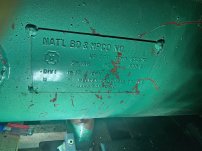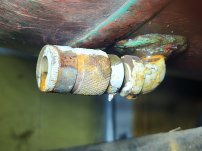GraterFang
Plastic
- Joined
- Jan 25, 2024
Hi all, new to the forum so hopefully I'm posting in the right place. I'm a hobbyist fabricator, but relatively new to air compressor service. I have recently acquired an older 80 gallon tank and compressor (unknown USA made) that I am getting back in working order. The pump required service but now works excellent. For the most part, the tank also appears to be in great shape too. However, there is a leak around the fitting for the drain at the bottom of the tank, and so I intended to replace it. However, when I went to remove it I found that the elbow fitting there simply spins without any significant resistance or axial travel (as an uncaptured bolt and nut would). I do not feel any stripped threads that are trying to bite, nor does it seem loose enough to just to be removed it even though it can be easily spun by hand. I was expecting an NPT thread fitting of some sort, so I was a bit surprised to find whatever this is. The bung that the fitting is in is rather mediocre as well, so while the possibility of tapping it out to a larger NPT thread exists, I worry that the bung may not be robust enough for that. I don't want to ruin a good pressure vessel by doing something stupid, so I figured I would see if this is typical behavior for a drain fitting on an air compressor tank, and if there were specific recommendations for how it would be best to proceed. I can try and get some pictures, but being on the bottom of the tank its hard to visualize right now. I'll almost surely need to address that to work on it, but have left it on the ground for now until I have a better idea of what to do next. I'm comfortable doing almost all operations, except welding on pressure vessels.



